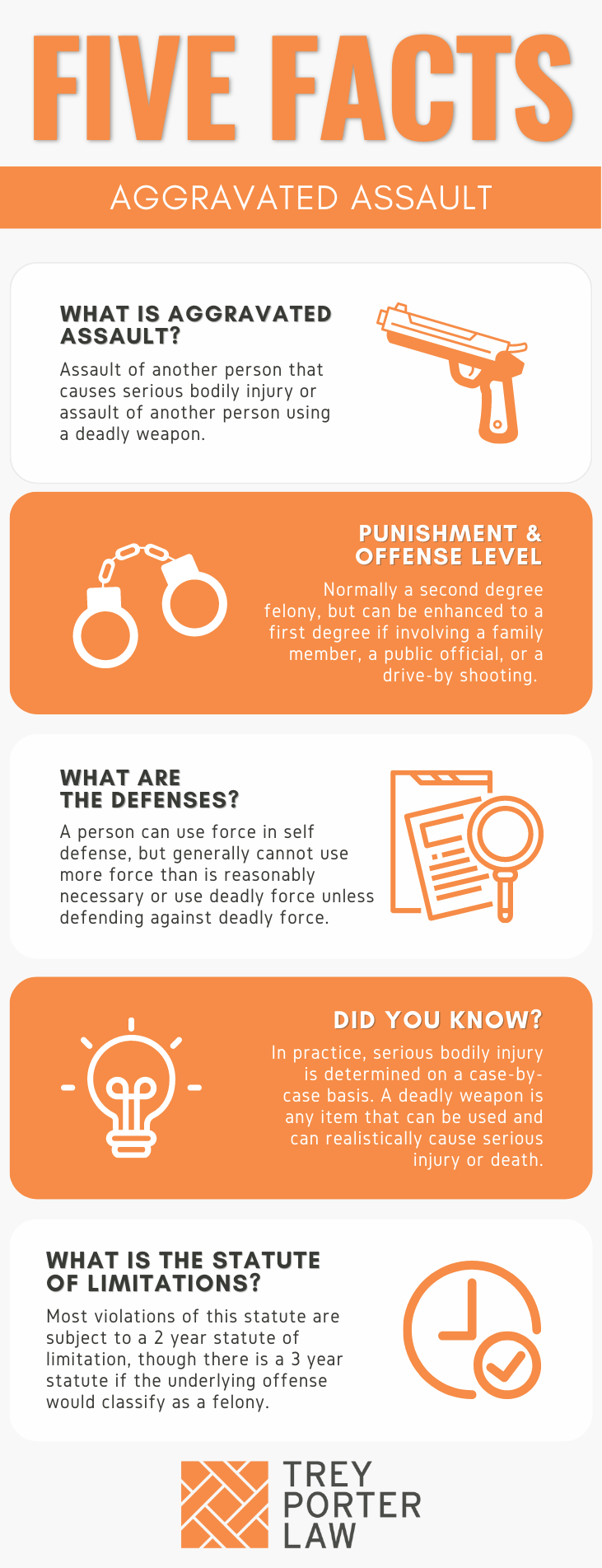WHAT IS AGGRAVATED ASSAULT IN TEXAS?
The Texas law against aggravated assault prohibits assaulting another, which is punishable aggravated assault, if the person either causes serious bodily injury, or uses or exhibits a deadly weapon during the assault.

WHAT IS THE AGGRAVATED ASSAULT LAW IN TEXAS?
Tex. Penal Code § 22.02. AGGRAVATED ASSAULT.
(a) A person commits an offense if the person commits assault and the person:
(1) causes serious bodily injury to another, including the person’s spouse; or
(2) uses or exhibits a deadly weapon during the commission of the assault.
(b) An offense under this section is a felony of the second degree, except that the offense is a felony of the first degree if:
(1) the actor uses a deadly weapon during the commission of the assault and causes serious bodily injury to a person whose relationship to or association with the defendant is described by Section 71.0021(b), 71.003, or 71.005, Family Code;
(2) regardless of whether the offense is committed under Subsection (a)(1) or (a)(2), the offense is committed:
(A) by a public servant acting under color of the servant’s office or employment;
(B) against a person the actor knows is a public servant while the public servant is lawfully discharging an official duty, or in retaliation or on account of an exercise of official power or performance of an official duty as a public servant;
(C) in retaliation against or on account of the service of another as a witness, prospective witness, informant, or person who has reported the occurrence of a crime;
(D) against a person the actor knows is a process server while the person is performing a duty as a process server; or
(E) against a person the actor knows is a security officer while the officer is performing a duty as a security officer; or
(3) the actor is in a motor vehicle, and:
(A) knowingly discharges a firearm at or in the direction of a habitation, building, or vehicle;
(B) is reckless as to whether the habitation, building, or vehicle is occupied; and
(C) in discharging the firearm, causes serious bodily injury to any person.
(c) The actor is presumed to have known the person assaulted was a public servant or a security officer if the person was wearing a distinctive uniform or badge indicating the person’s employment as a public servant or status as a security officer.
WHAT IS THE PENALTY CLASS FOR AGGRAVATED ASSAULT IN TEXAS?
Aggravated assault is a second degree felony, punishable by two to 20 years in prison. Aggravated assault becomes a first degree felony, punishable by five to 99 years or life in prison, if the offense is committed:
- by a public servant while acting under color of his or her office or employment;
- against a family or household member, or one with whom the person has or has had a dating relationship, and the person:
- uses or exhibits a deadly weapon; and
- causes serious bodily injury;
- against a public servant on duty;
- against a process server performing his or her duties;
- against a security officer acting in his or her official capacity;
- against a witness, prospective witness, informant, or person who has reported a crime in retaliation for or on account of their service;
- while the person is driving a motor vehicle, and the person:
- discharges a firearm at or in the direction of a house, building, or vehicle; and
- causes serious bodily injury to any person.
WHAT IS THE PUNISHMENT RANGE FOR AGGRAVATED ASSAULT IN TEXAS?
The punishment range for a second degree felony aggravated assault is between two and 20 years in prison, and a maximum $10,000 fine. If it is classified as a first degree felony, the punishment range is five to 99 years or life in prison, and up to a $10,000 fine.
WHAT ARE THE PENALTIES FOR AGGRAVATED ASSAULT IN TEXAS?
A person charged with aggravated assault may be eligible for probation after a conviction, or deferred adjudication without a conviction, under some circumstances. A person accused of using or exhibiting a deadly weapon during the aggravated assault may not receive probation from a judge. A person charged with aggravated assault causing serious bodily injury may be placed on either type of community supervision for up to ten years, and a jury may recommend probation for a person charged with aggravated assault with a deadly weapon for up to ten years.
- What is a deadly weapon?Texas Penal Code Section 1.07(17) defines a “deadly weapon” as “(A) a firearm or anything manifestly designed, made, or adapted for the purpose of inflicting death or serious bodily injury; or (B) anything that in the manner of its use or intended use is capable of causing death or serious bodily injury.”For an object to be considered a deadly weapon, it must have more than a hypothetical capability of causing death. The State must show the accused intended a violent use of a non-traditional weapon capable of causing serious bodily injury or death, and it was actually capable of doing so. See Flores v. State, 620 S.W.3d 154 (Tex. Crim. App. 2021).
WHAT ARE THE DEFENSES TO AGGRAVATED ASSAULT IN TEXAS?
The justification defenses are available in prosecutions for aggravated assault if the accused presents evidence to support them. A person accused of aggravated assault may also attempt to negate one of the elements the State must prove at trial.
- What is the necessity defense?According to Texas Penal Code Section 9.22, conduct ordinarily considered criminal is justified under the necessity defense if: (1) the actor reasonably believes the conduct is immediately necessary to avoid imminent harm; (2) the desirability and urgency of avoiding the harm clearly outweigh, according to ordinary standards of reasonableness, the harm sought to be prevented by the law proscribing the conduct; and (3) a legislative purpose to exclude the justification claimed for the conduct does not otherwise plainly appear.Necessity requires confession and avoidance, meaning the accused must admit to the allegation, but argue it was immediately necessary to avoid harm.
In Juarez v. State, a defendant was charged with aggravated assault against a peace officer after he bit the officer’s finger while resisting arrest. The defendant testified he felt like he was suffocating when the officer was on top of him, and admitted to biting the officer’s finger to get him off so he could breathe. The trial court refused to give a necessity instruction, but the Texas Court of Criminal Appeals reversed. The jury should have been permitted to consider whether his conduct was justified as necessary under the circumstances.
- Is there a “mutual combat” defense to assault?Texas Penal Code Section 22.06 authorizes a person charged with assault to raise the defense of consent, or “mutual combat,” if the victim and accused agreed to fight before the alleged assault occurred. The consent defense does not apply to an assault during a gang initiation.For the defense of consent to apply, the accused must show:
- the victim, or “complainant,” effectively consented to the accused’s conduct or the accused reasonably believed that the complainant consented to the accused’s conduct; and
- the accused’s conduct did not threaten or inflict serious bodily injury, or
- the complainant knew the conduct was a risk of his occupation, recognized medical treatment, or a scientific experiment conducted by recognized methods.
- the victim, or “complainant,” effectively consented to the accused’s conduct or the accused reasonably believed that the complainant consented to the accused’s conduct; and
- What is self-defenseTexas Penal Code Section 9.31 explains a person is justified in using force against another when and to the degree he reasonably believes force is immediately necessary to protect against the other’s use or attempted use of unlawful force.The accused need not prove the victim was actually using force—a person has the right to defend himself from apparent danger as he reasonably apprehends it. A person’s use of force is presumed reasonable if used against another who was:
- unlawfully entering or attempting to enter the person’s home, vehicle, or place of business or employment;
- unlawfully removing or attempting to remove the person from his or her home, vehicle, or place of business or employment; or
- committing or attempting to commit aggravated kidnapping, murder, sexual assault, aggravated sexual assault, robbery, or aggravated robbery.
A person may not use force in response to verbal provocation alone, or if the person provoked the victim’s initial use of force.
- May a person kill another, or use deadly force, in self-defense?Texas Penal Code Section 9.32 explains a person is justified in using deadly force against another if:
- the actor would be justified in using force against the other under Section 9.31; and
- when and to the degree the actor reasonably believes the deadly force is immediately necessary:
- to protect the actor against the other’s use or attempted use of unlawful deadly force; or
- to prevent the other’s imminent commission of aggravated kidnapping, murder, sexual assault, aggravated sexual assault, robbery, or aggravated robbery.
- What if the accused started the fight prior to assaulting the other person?If the accused “provoked the difficulty,” he or she forfeits any claim of self-defense. Texas courts have interpreted this as more than merely starting the fight. Rather, self-defense is forfeited when an accused provoked the attack in a manner reasonably calculated to give the defendant a pretext for inflicting harm.The State must show: (1) the defendant provoked the attack through action or words; (2) the action or words were reasonably calculated to provoke the attack; and (3) the provocation was intended to give the defendant a pretext for inflicting harm. See Elizondo v. State, 487 S.W.3d 185 (Tex. Crim. App. 2016).
- What is serious bodily injury?Texas Penal Code Section 1.07(46) defines “serious bodily injury” as “bodily injury that creates a substantial risk of death or that causes death, serious permanent disfigurement, or protracted loss or impairment of the function of any bodily member or organ.”There are no wounds that are serious bodily injury per se. It is up to the jury in each case to determine as a matter of fact whether a particular injury is serious. Expert medical testimony is one way to establish serious bodily injury, but is not required.
In Garcia v. State, the defendant was convicted of first-degree felony aggravated assault against his girlfriend under Subsection 22.021(b)(1). He shot his girlfriend several times in a jealous rage, and she was hit in the chest and thigh. The defendant argued she did not suffer serious bodily injury, because she only spent three hours in the hospital, and healed completely from her wounds. But the treating physician testified her gunshot wounds required stitches, and could have been life-threatening, which was sufficient evidence of serious bodily injury.
WHAT IS THE STATUTE OF LIMITATIONS FOR AGGRAVATED ASSAULT IN TEXAS?
Texas Code of Criminal Procedure article 12.03(d) explains the limitation periods for aggravated offenses are regulated by the same statute of limitations as their primary, non-aggravated crimes. In most cases, the limitation period for aggravated assault is two years. See State v. Schunior, 506 S.W.3d 29 (Tex. Crim. App. 2016).
However, if the underlying assault without the aggravating factor would be a felony, the limitation period of the aggravated assault charge is three years.
- For example, in Lee v. State, the defendant was charged with aggravated assault against a public servant. Because assaulting a public servant is a felony with a three-year limitation period, even without the aggravating factor of using a deadly weapon, the limitation period for aggravated assault against a public servant is three years.
AGGRAVATED ASSAULT IN TEXAS
Aggravated assault may be committed by threatening another while using or exhibiting a deadly weapon, or by causing serious bodily injury to another. Serious bodily injury is determined on a case-by-case basis, and may not be obvious in every case. Deadly weapons include anything that may be used to cause serious bodily injury or death.
TEXAS AGGRAVATED ASSAULT COURT CASES
The case law regarding aggravated assault in Texas illustrates the statute’s application, and types of conduct constituting aggravated assault.
- In Olivas v. State, the defendant was convicted of aggravated assault with a deadly weapon after shooting at the victim’s truck. The victim testified she heard the “pops” hitting her truck, but did not immediately know the defendant shot at her until she saw him drive away, got out of her truck, and noticed bullet holes. He argued on appeal the victim did not perceive the threat.The Court of Criminal Appeals affirmed, explaining a victim of a threat need not perceive the precise threat when it is made. The victim said she was scared upon seeing the defendant, and then the bullet holes, which was sufficient.
- In Thompson v. State, the defendant was a pastor at a church, who beat the 11-year-old victim with a tree branch at least 100 times for misbehaving in Bible study. This led to hypovolemic shock, and nearly killed the child. The defendant was convicted of first degree felony injury to a child, and aggravated assault with a deadly weapon.The defendant argued on appeal he only intended to cause bodily injury, not serious bodily injury, so the offense should have been a third degree felony. The Court of Criminal Appeals held his mistake-of-fact defense did not negate transferred intent, so he was criminally responsible for foreseeable results.
- In Wade v. State, the defendant was convicted of aggravated assault causing serious bodily injury after starting a fight with his ex-wife’s boyfriend, and biting his earlobe off. At trial, he testified the victim did not appear permanently disfigured. The trial court denied his requested instruction for the lesser-included offense of assault.The Court of Criminal Appeals agreed a severed earlobe can be serious bodily injury, especially because the jury found as such, but reversed because the trial court erred by refusing the lesser-included instruction. There was a “valid, rational alternative” to aggravated assault, so the lesser was required.
















